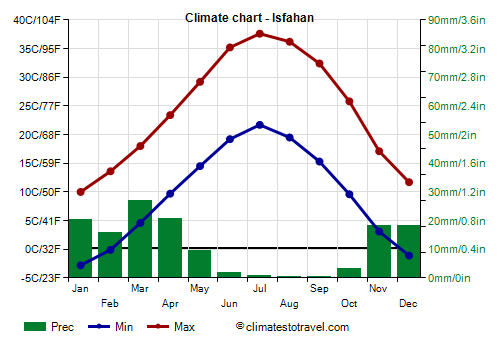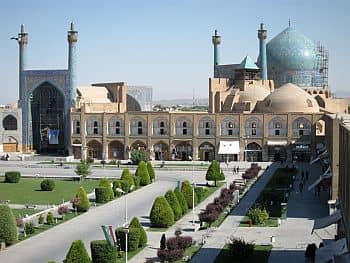Select units of measurement for the temperature and rainfall tables (metric or imperial).
Average weather, temperature, rainfall, sunshine hours

The climate of Isfahan is
subtropical desert, with quite cold winters and very hot, sunny summers. Precipitation, decidedly scarce, occurs mostly from November to April.
Isfahan (or Esfahan) is a city located in central Iran, in the province of the same name (of which it is the capital), at 32 degrees north latitude and 1,500 meters (4,900 feet) above sea level. With 2,200,000 inhabitants (4 million including the metropolitan area) it is the third largest city in Iran.
Due to its location in a valley, air tends to stagnate, especially in autumn and winter, and pollution is high.
Although the climate is desert, the city receives water from the
Zayandeh River, which flows down from the Zagros Mountains and has no outlet to the sea, but is lost in the Gavkhouni salt marshes, which are located 110 km (70 mi) southeast of the city and are drying up.
 Winter
Winter, from December to February, is quite cold, with frequent night frosts. Fog can form during periods of stable weather.
There can be mild periods, with highs of 15 °C (59 °F) or more, but also cold periods, during which snowfalls can occur, generally not abundant given the low level of precipitation. During cold spells, the temperature can drop to -10 °C (14 °F) or below. In January 1996, it dropped to -19.4 °C (-2.9 °F).
Summer, from June to August, is very hot, although humidity is low. On hotter days, the temperature can exceed 40 °C (104 °F). In July 2024, it reached 44.6 °C (112.2 °F), and the average high was 41.5 °C (106.7 °F).
Isfahan - Climate data
In Isfahan, the
average temperature of the coldest month (January) is of
3.6 °C, that of the warmest month (July) is of
29.6 °C. Here are the average temperatures.
Isfahan - Average temperatures (1991-2020) |
| Month | Min | Max | Mean |
|---|
| January | -2.8 | 10 | 3.6 |
|---|
| February | -0.1 | 13.6 | 6.8 |
|---|
| March | 4.6 | 18 | 11.3 |
|---|
| April | 9.7 | 23.4 | 16.5 |
|---|
| May | 14.5 | 29.2 | 21.8 |
|---|
| June | 19.2 | 35.2 | 27.2 |
|---|
| July | 21.7 | 37.6 | 29.6 |
|---|
| August | 19.5 | 36.2 | 27.8 |
|---|
| September | 15.3 | 32.4 | 23.8 |
|---|
| October | 9.6 | 25.8 | 17.7 |
|---|
| November | 3.1 | 17.1 | 10.1 |
|---|
| December | -1.1 | 11.7 | 5.3 |
|---|
| Year | 9.5 | 24.2 | 16.8 |
|---|
amounts to
135 millimeters per year: it is therefore at a desert level. It ranges from
0.1 millimeters in the driest month (September) to
27.1 millimeters in the wettest one (March). Here is the average precipitation.
Isfahan - Average precipitation| Month | Days |
|---|
| January | 20 | 4 |
|---|
| February | 16 | 3 |
|---|
| March | 27 | 4 |
|---|
| April | 21 | 4 |
|---|
| May | 9 | 2 |
|---|
| June | 2 | 0 |
|---|
| July | 1 | 0 |
|---|
| August | 0 | 0 |
|---|
| September | 0 | 0 |
|---|
| October | 3 | 1 |
|---|
| November | 18 | 3 |
|---|
| December | 18 | 3 |
|---|
| Year | 135 | 22 |
|---|
There are on average around 3370
sunshine hours per year. Here are the average hours of sunshine per day.
Isfahan - Sunshine hours| Month | Average | Total |
|---|
| January | 7 | 210 |
|---|
| February | 8 | 230 |
|---|
| March | 8 | 255 |
|---|
| April | 8.5 | 260 |
|---|
| May | 10 | 315 |
|---|
| June | 12 | 360 |
|---|
| July | 11.5 | 355 |
|---|
| August | 11.5 | 360 |
|---|
| September | 10.5 | 320 |
|---|
| October | 9 | 285 |
|---|
| November | 7 | 215 |
|---|
| December | 6.5 | 200 |
|---|
| Year | 9.2 | 3370 |
|---|